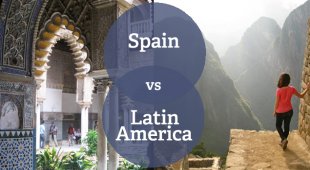
How to best Learn Spanish?
 Overall, grammar throughout Spanish is fairly consistent (and mercifully much less complicated than English grammar). The only major difference comes from personal pronouns and related verb conjugations - with vosotros (y'all) being predominantly used in Spain, and ustedes more common in Latin America. Further, Spanish speakers in Argentina, Uruguay, parts of eastern Bolivia, Nicaragua, and Costa Rica will often use "vos" instead of using the common "tu" for second person.
Overall, grammar throughout Spanish is fairly consistent (and mercifully much less complicated than English grammar). The only major difference comes from personal pronouns and related verb conjugations - with vosotros (y'all) being predominantly used in Spain, and ustedes more common in Latin America. Further, Spanish speakers in Argentina, Uruguay, parts of eastern Bolivia, Nicaragua, and Costa Rica will often use "vos" instead of using the common "tu" for second person.
As with any other language, accents are one of the biggest differentiators between the languages spoken in different countries. The main way to identify someone from Spain almost immediately is by the famous Castilian accent, in which the letters Z (before all vowels) and C (before E and I) are pronounced with a "th" sound - meaning the word "zapato" actually sounds like "thapato." Of course, not everyone in Spain has this accent, especially in some of the more independent regions.
The difference between accents throughout Latin America could be the topic of a whole additional article, as there's enormous diversity from the Rio Grande to Tierra del Fuego - though one of the easiest ways to distinguish between the major regions is to listen to how the speaker pronounces the Y or LL sound.
Vocabulary as well varies widely from country to country - which makes our first question the most important:
What Do You Want to Use Your Spanish For?
If you're just hoping to brush up on your culinary vocabulary to apply for a job in a tapas restaurant, you're better off studying Spanish in Spain, since that will help you the most. If you volunteer at a school where half of the parents come from the Dominican Republic, or want to gain the language skills you need to do medical translating for a predominantly Mexican population, you're far better off learning the Spanish specific to that group, ideally in that country.
 Any Spanish is better than nothing, of course, but learning the closest version to the accent used by the people you'll be interacting with is guaranteed to make your life (and their lives) easier.
Any Spanish is better than nothing, of course, but learning the closest version to the accent used by the people you'll be interacting with is guaranteed to make your life (and their lives) easier.
Where Are You From?
If your goals are less specific, and you just generally want to learn Spanish conversationally, take into consideration where you're from and the opportunities you'll have to speak Spanish once you're back home.
Residents of the EU, for example, may be better off sticking with the European version, while those in the United States would be best served by learning Spanish more similar to that spoken in Mexico or Central America, since those are the speakers they're most likely to interact with at home.
What's Your Level of Fluency?
It's generally accepted that the Southern Cone (Argentina, Chile, and Uruguay) and Caribbean countries have some of the most challenging accents for Spanish learners - especially when they're talking a mile a minute. Spain Spanish can also be difficult for newbie learners, though if you've had your foundation in Spain Spanish, it could make sense to continue with this route and learn Spanish in Spain.
If you're an absolute beginner or only know a little bit of Spanish, you'll want an accent that's easier to understand without needing to say "más despacio, por favor" (slower please) every 30 seconds. For you, you're best off learning Spanish in central Colombia, Ecuador, Costa Rica, and Peru.
For Spanish learners with a higher command of the language, or with very specific goals in mind for learning Spanish, your options are much broader, and ease of understanding said country's version of Spanish might not be a deciding factor for where you ultimately learn Spanish.
 For more in-depth details on the different types of Spanish you could learn throughout Latin America, below is a break down of accents and styles by region:
For more in-depth details on the different types of Spanish you could learn throughout Latin America, below is a break down of accents and styles by region:
Mexican Spanish
Cooking class in Mexico | Photo Credit: Jessie Beck
Mexican Spanish is so distinctive that it is essentially its own dialect, though it also includes a number of internal variations: the Yucatán Peninsula has its own unique Spanish, while speakers in southern Mexico sound more like Central Americans and those in the north and the United States speak what's familiarly known as Tex-Mex.
Mexican Spanish incorporates a large number of indigenous words, giving it several unique sounds, while the overall preservation of the letter S at the end of words differentiates Mexican speakers from their Central American and Caribbean neighbors. Depending on your goals, this could or could not be right for you.
Caribbean Spanish
Caribbean is spoken very quickly and characterized by the tendency to drop certain letters or syllables, particularly the letters S and D at the ends of words - so that "helado" becomes "hela'o" and "escuelas" sounds like "ehcuela." This accent is predominant in Cuba, the Dominican Republic, Puerto Rico, Venezuela, Panama, and Colombia's Caribbean coast, and can be difficult for beginners.
Central American Spanish
Central American Spanish is fairly standard and not significantly different from South American Spanish, at least in terms of pronunciation. One distinctive feature is that the letter S at the end of a syllable is often pronounced like H. This castellano is spoken throughout Costa Rica, El Salvador, Guatemala, Honduras, and Nicaragua - Panama falls into the Caribbean category and Mexican Spanish is its own category. It's a great option for beginners and intermediate learners who want a more "universal" Spanish.
South American Spanish
South American Spanish is essentially a false construct, as the geography and history of the continent have helped create a number of wildly different versions of the language. Each country has its own particular style of speaking and internal accents.
Central and southern Colombia, Ecuador, Peru, and Bolivia speak a fairly similar style of Andean Spanish, with a significant incorporation of Quechua, Aymara, and other indigenous languages, especially in Peru and Bolivia.
Both Chile and Argentina are extremely distinctive for their accents and speaking style (Argentina being surprisingly similar to Spain Spanish), while Paraguay falls somewhere between the two, with Uruguay adopting a version very similar to Argentina.

















